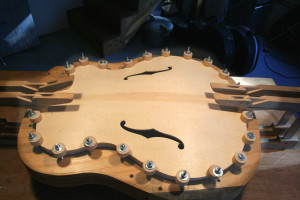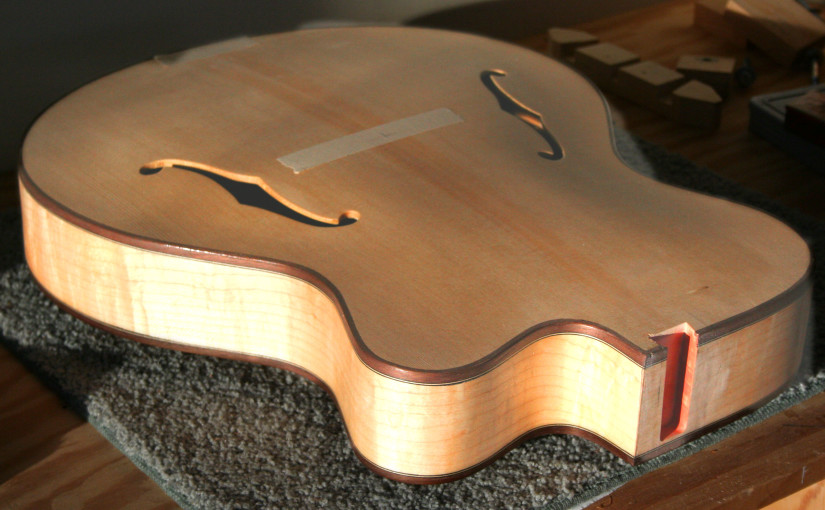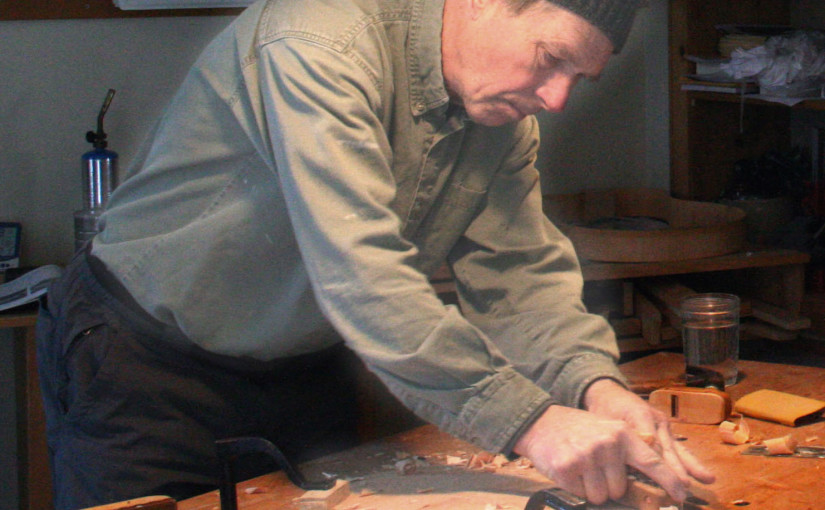The redwing blackbirds appeared yesterday for the first time, and the snow is starting to melt.
Month: March 2015
Archtop – binding the body and making the neck
After assembling the body the ledges for the binding are cut and the binding glued and scraped smooth. I chose to use black walnut for the contrast with the white maple. There are two pieces to the binding all the way around, a taller piece with some black-white purfling on the bottom and a small square piece that sits inside the outer piece and adds visual depth. The walnut is first bent to shape on the bending iron – 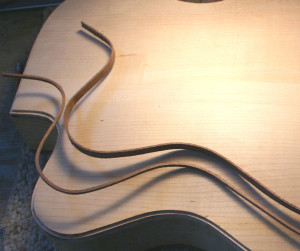 the pieces are about 3/32″ thick and I have to bend slowly to prevent breaks. The binding ledge is a two-step affair, cut with two passes on a router setup in a router table with a special cutter guide that sets the depth and height of cut. Gluing the binding is a messy process – everything is held in place with masking tape until the glue dries –
the pieces are about 3/32″ thick and I have to bend slowly to prevent breaks. The binding ledge is a two-step affair, cut with two passes on a router setup in a router table with a special cutter guide that sets the depth and height of cut. Gluing the binding is a messy process – everything is held in place with masking tape until the glue dries – 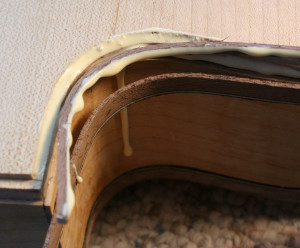 but careful work starting with a small block plane and going to a cabinet scraper yields satisfyingly clean results –
but careful work starting with a small block plane and going to a cabinet scraper yields satisfyingly clean results – 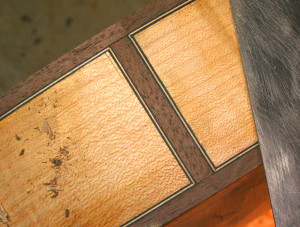 After the binding is done, about six hours of sanding results in the body being ready for the first finish coat – a sealer of thin shellac which protects it from stains and minor dings during the remaining processes. Then, the neck dovetail is cut using a router and jig and 1/2″ dovetail bit. Below, it has been coated with red chalk to facilitate fitting the neck dovetail.
After the binding is done, about six hours of sanding results in the body being ready for the first finish coat – a sealer of thin shellac which protects it from stains and minor dings during the remaining processes. Then, the neck dovetail is cut using a router and jig and 1/2″ dovetail bit. Below, it has been coated with red chalk to facilitate fitting the neck dovetail.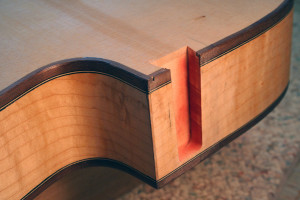
I had a few pieces of 3×3″ quarter-sawn stock I kept from the tree this guitar body came from (it’s a graveyard guitar, remember?) and I chose one of these to make the 1-piece neck. Below is the neck ready for gluing the fingerboard on – peghead ears and veneer (curly maple) glued on, peghead tapered to final thickness, truss rod slot cut, truss rod and truss rod cover installed, dovetail cut and fingerboard extension glued on. Next step is to glue the fingerboard on, radius it and finish sand it, put in the frets, level and dress the frets, carve the neck to its final shape, sand and put on a shellac sealer coat, fit the dovetail and glue the neck on.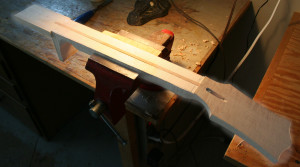
Finished, minus the finger rest and pickup –
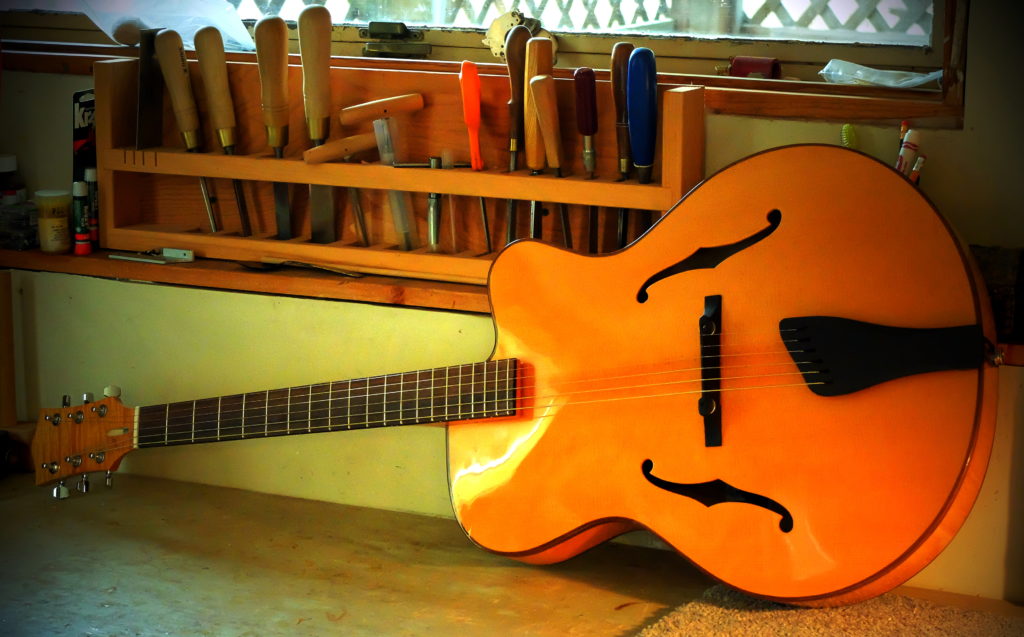
Archtop – carving the plates and assembling the body
Starting with the glued-up top and back wedges, the outside contours are established with a gouge and hand planes using templates as a guide. 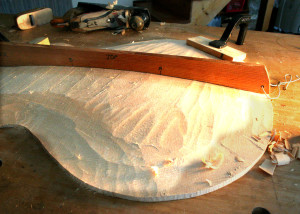 I use Bob Benedetto’s book on archtop guitar making as my main reference, and the templates I use are from his book. There are templates for the lateral curves too –
I use Bob Benedetto’s book on archtop guitar making as my main reference, and the templates I use are from his book. There are templates for the lateral curves too – 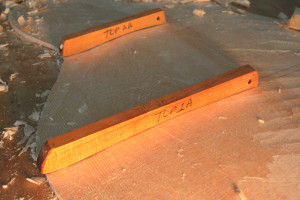 once the basic shape is established it is a matter of smoothing the contours to blend together, ending up with a cabinet scraper.
once the basic shape is established it is a matter of smoothing the contours to blend together, ending up with a cabinet scraper. 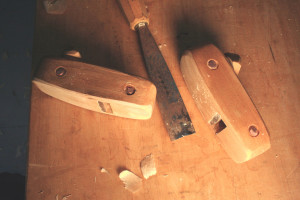 These are the tools I use to carve the plates – a Swiss gouge, and two small wood bodied hand planes made from drawings in Irving Sloane’s book on guitar making. The hand planes have blades of Japanese steel that came from Woodcraft. One plane is arched both ways, the other is only arched in the long dimension. The two halves of the plane bodies are glued and riveted with copper rivets. When the outsides of the plates present pleasing curves –
These are the tools I use to carve the plates – a Swiss gouge, and two small wood bodied hand planes made from drawings in Irving Sloane’s book on guitar making. The hand planes have blades of Japanese steel that came from Woodcraft. One plane is arched both ways, the other is only arched in the long dimension. The two halves of the plane bodies are glued and riveted with copper rivets. When the outsides of the plates present pleasing curves – 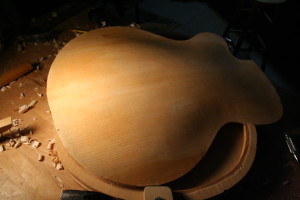 they are used to establish the rough shape of the inside by taking them to the drill press which has been set up with a 1/2″ bit that stops 1/4″ above the table – this leaves a series of holes that gauge the rough-out depth of the inside. It is a matter of work to bring the inside down to the level of the gauge-holes –
they are used to establish the rough shape of the inside by taking them to the drill press which has been set up with a 1/2″ bit that stops 1/4″ above the table – this leaves a series of holes that gauge the rough-out depth of the inside. It is a matter of work to bring the inside down to the level of the gauge-holes – 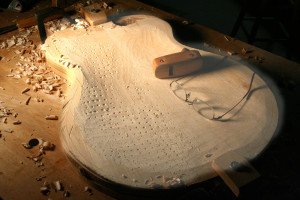 From there, the plates are thinned to their approximate final thickness using the planes and a thickness caliper – the back is taken to a uniform 3/16″ and the top varies from just shy of 1/4″ down the center to 1/8″ around the edges. I did not use binding on the f-holes and felt that this particular piece of spruce needed some reinforcement that would normally have been provided by the f-hole binding. So – a very thin red cedar veneer was added on the inside, with the grain of the veneer running across the grain of the top. I chose to use an X-brace on this top to help distribute the vibrations to the outside of the plate, and gave the whole inside of the body a light coat of shellac to help retard moisture transfer in-and-out. The back was glued to the sides before gluing on the top. The top – ready to assemble –
From there, the plates are thinned to their approximate final thickness using the planes and a thickness caliper – the back is taken to a uniform 3/16″ and the top varies from just shy of 1/4″ down the center to 1/8″ around the edges. I did not use binding on the f-holes and felt that this particular piece of spruce needed some reinforcement that would normally have been provided by the f-hole binding. So – a very thin red cedar veneer was added on the inside, with the grain of the veneer running across the grain of the top. I chose to use an X-brace on this top to help distribute the vibrations to the outside of the plate, and gave the whole inside of the body a light coat of shellac to help retard moisture transfer in-and-out. The back was glued to the sides before gluing on the top. The top – ready to assemble – 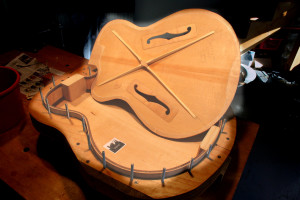 and, in the gluing form with the spool clamps tightened up – more to come.
and, in the gluing form with the spool clamps tightened up – more to come.